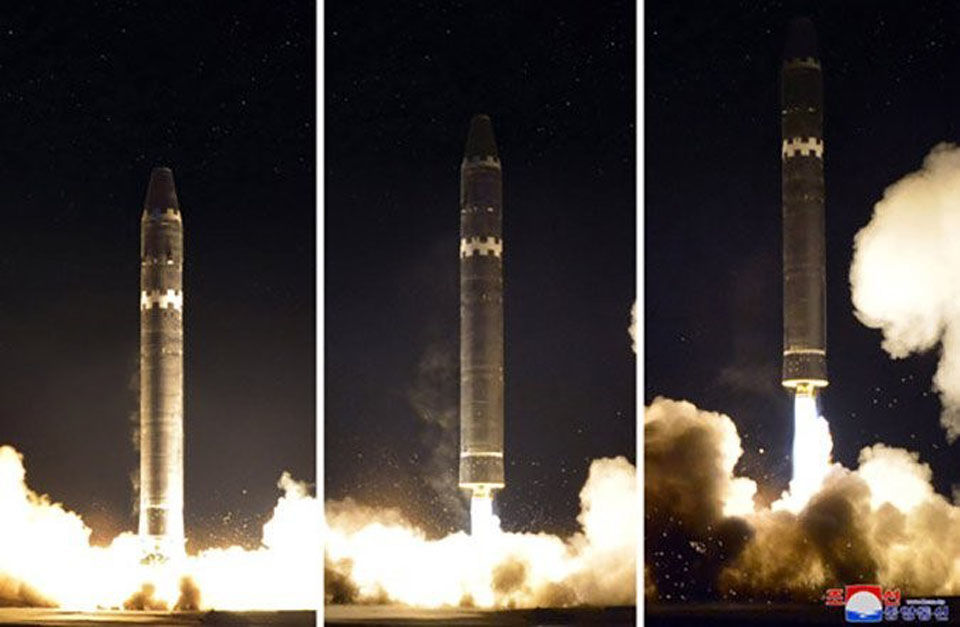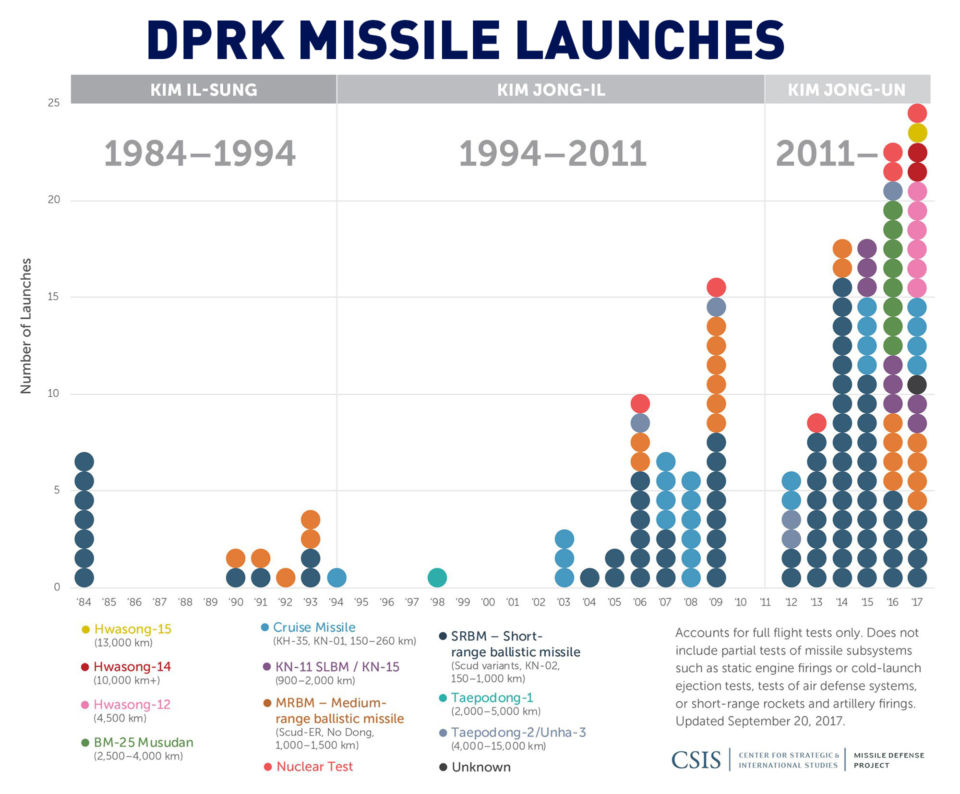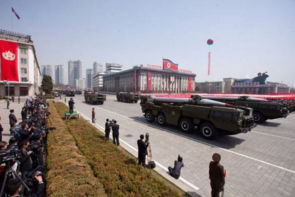Along with the DPRK’s nuclear weapons program, there has been steady progress in Pyongyang’s development of ballistic missiles. On November 28, 2017, the DPRK demonstrated that, at least in theory, their new inter-continental ballistic missiles could reach the entire continental United States.
Below is a chart from the Center for Strategic and International Studies (CSIS) that shows the estimated range of DPRK’s known missiles.
This chart shows how, since 1984, DPRK’s missile tests have grown in both number and variety.
Using additional research from CSIS, we have compiled a short list of milestones in DPRK’s missile program development.
1984 – Short Range Ballistic Missiles (SRBM)
(Scud B variant Hwasong-5) The DPRK begins developing short range ballistic missiles (SRBM) whose reach is believed around 300 km. [STATUS: Operational 1986]
1990 – Medium Range Ballistic Missiles (MRBM)
(Extended range Scud-C, No Dong) The introduction of medium range ballistic missiles (MRBM) extended DPRK’s missile range up to 1,500 km.[STATUS: Operational 1994]
1994 – Cruise Missiles
(KN-01) DPRK introduced anti-ship cruise missiles that are reportedly road-mobile, as well as sea- and air-launchable. There are conflicting estimates of their range, varying from 110-160 km. [STATUS: Operational]
1990 – Intermediate Range Ballistic Missile (IRBM)
The Taepodong-1 extended DPRK’s missile range to 2,000 km (two-stage model) and 5,000 km (three-stage model). Pyongyang conducted one test in August 1998. The first two stages performed as expected. The third stage malfunctioned. [STATUS: Prototype]
2006 – Satellite launch technology extends missile range
The same year the DPRK conducted its first nuclear weapons test, Pyongyang also tested the Taepodong 2, an IRBM reported to use a three stage satellite launch vehicle. It has an estimated range of 4,000 to 10,000 km. [STATUS: Tested]
 2015 – Submarine class ballistic missiles
2015 – Submarine class ballistic missiles
The KN-11 is a submarine-launched ballistic missile (SLBM) with a reported range of about 1,200 km. Its land based counterpart, the KN-15 MRBM, has a longer reported range—up to 2,000 km. [STATUS: In development]
2016 – Single stage IRBM
The BM-25 Musudan is a single-stage intermediate-range ballistic missile with a possible range of 2,500–4,000 km. The DPRK tested the BM-25 Musudan eight times in 2016. Four prototypes failed—with one exploding on the launch pad and two others exploding shortly after liftoff. One travelled 400 kilometers before falling into the Sea of Japan.
In contrast to previous missiles using kerosene based fuel, this system is propelled by dimethyl hydrazine (UDMH) and nitrogen tetroxide (NTO). As a result, the Musudan could have a greater range without additional stages that add significant weight to the missile. [STATUS: In development]
2017 – Hwasong-12
The Hwasong-12 is a single-staged, liquid-fueled IRBM with an estimated range of 4,500 km. Out of six reported test flights, three were successful. [STATUS: In development]
2017 – DPRK’s first ICBM
The Hwasong-14 is the DPRK’s first intercontinental ballistic missile (ICBM), first tested on July 4, 2017. Its approximate range is over 10,000 km, making it capable of reaching most of the continental United States. [STATUS: In development]
2017 – Hwasong-15 could put the world within reach
On November 29, 2017, the DPRK tested the Hwasong-15—a two-stage liquid fueled rocket. Flying for approximately 53 minutes, it travelled a distance of 960 km, reaching an altitude of around 4,500 km before crashing into the Sea of Japan. Based on the energy required to reach that altitude, analysts say the Hwasong-15 could potentially travel 13,000 km, putting the entire continental United States within range.
Reports are unclear whether this test flight carried a payload of weight comparable to a nuclear device. The payload weight will affect the missile’s range. [STATUS: In development]
 CGTN America
CGTN America






